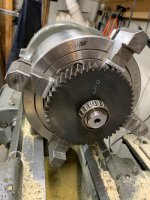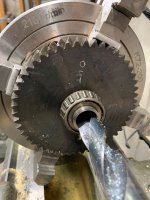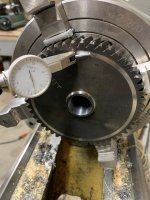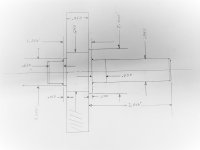Thanks to everybody for your inputs on this project, especially Jthibodeau. I'm very happy to report some excellent progress on this.
I don't have any huge aluminum pipe that would match this gear, so some aluminum seats were made, one for each chuck jaw. The gear was set in the 4 jaw chuck with an indicator on the shaft surface and also on the side of the gear. It was dialed in to within .0005". I was happy to see that the shaft was hardened only at the surface. Still it wasn't too hard for an HSS cutter or drill bit to get through it. It was tough on the surface but then cut nicely once through that.

Went through a long series of drill bits to bore out the old shaft, taking off about 1/32" with each bit. Lots of oil.

When the shaft was reduced to about .015" remaining, it was time to switch to a carbide boring bar. The squeal from the HSS drill let me know that it was getting into the hard surface.

After a few passes with the boring bar, the bearings dropped off. A couple more passes were taken to clean up the radius that was there in the gear/shaft interface (one-piece forged part!!!!). Now the gear has to come out of the chuck so the spacing of the bearings can be measured. A reference surface was turned on the side of the gear so it can be re-aligned perfectly. The side of the gear was originally machined with a very coarse feed, and those mill marks made it hard to be certain that the gear face was perfectly aligned. At least it can now be returned to the alignment used while boring the center hole.

This will lead to a series of questions that I will need help with. I'll put those in the next post.
I don't have any huge aluminum pipe that would match this gear, so some aluminum seats were made, one for each chuck jaw. The gear was set in the 4 jaw chuck with an indicator on the shaft surface and also on the side of the gear. It was dialed in to within .0005". I was happy to see that the shaft was hardened only at the surface. Still it wasn't too hard for an HSS cutter or drill bit to get through it. It was tough on the surface but then cut nicely once through that.

Went through a long series of drill bits to bore out the old shaft, taking off about 1/32" with each bit. Lots of oil.

When the shaft was reduced to about .015" remaining, it was time to switch to a carbide boring bar. The squeal from the HSS drill let me know that it was getting into the hard surface.

After a few passes with the boring bar, the bearings dropped off. A couple more passes were taken to clean up the radius that was there in the gear/shaft interface (one-piece forged part!!!!). Now the gear has to come out of the chuck so the spacing of the bearings can be measured. A reference surface was turned on the side of the gear so it can be re-aligned perfectly. The side of the gear was originally machined with a very coarse feed, and those mill marks made it hard to be certain that the gear face was perfectly aligned. At least it can now be returned to the alignment used while boring the center hole.

This will lead to a series of questions that I will need help with. I'll put those in the next post.

